Determination of the Shear Angle in the Orthogonal Cutting Process
Abstract
:1. Introduction
2. Materials and Methods
2.1. Materials
2.2. Methods
2.2.1. Analytic
2.2.2. Simulation
3. Results and Discussion
3.1. Experimental and Analytical Determination of the Shear Angle
3.2. Determination of Shear Angle Using Numerical Simulation
4. Conclusions
- Based on the use of the chip compression ratio and the minimum potential energy principle, analytical methods for determining the shear angle produced insignificantly greater values than experimentally established shear angle values for the studied range of cutting speeds and tool rake angles:
- ➢
- The shear angles determined by the chip compression ratio were insignificantly lower (up to 1°–2°) than the shear angles determined by the minimum potential energy principle.
- ➢
- The greatest variation between the values of shear angles determined experimentally and analytically was no more than 12%.
- ➢
- Thus, the examined analytical methods for determining the shear angle can be used instead of time-consuming experimental studies.
- The shear angle value in the numerical simulation of the orthogonal cutting process was mainly influenced by the constitutive equation parameters: initial yield stress A, coefficient of strain hardening B, power coefficient of hardening n, and strain rate coefficient C.
- The generalized values of these parameters for simulating the cutting process at a wide range of machining conditions were determined by means of a software algorithm based on finding the intersection of the constitutive equation parameter sets.
- Using these generalized parameters produced the largest deviation between experimental and simulated shear angle values of 9% to 18% and between simulated and analytically calculated shear angle values of 7% to 12%.
Author Contributions
Funding
Data Availability Statement
Acknowledgments
Conflicts of Interest
References
- Melkote, S.; Liang, S.Y.; Ozel, T.; Jawahir, I.S.; Stephenson, D.A.; Wang, B. A Review of Advances in Modeling of Conventional Machining Processes: From Merchant to the Present. ASME J. Manuf. Sci. Eng. 2022, 144, 110801. [Google Scholar] [CrossRef]
- Mourtzis, D.; Doukas, M.; Bernidaki, D. Simulation in Manufacturing: Review and Challenges. Procedia CIRP 2014, 25, 213–229. [Google Scholar] [CrossRef] [Green Version]
- Arrazola, P.J.; Özel, T.; Umbrello, D.; Davies, M.; Jawahir, I. Recent advances in modelling of metal machining processes. CIRP Ann. Manuf. Technol. 2013, 62, 695–718. [Google Scholar] [CrossRef]
- Zvorikin, K.A. Required work and force for separation of metal chip. In Engineering Collection and Manufacturing News; Russkaya Tipo-Litogr: Moscow, Russia, 1893; 91p. (In Russian) [Google Scholar]
- Ernst, H.; Merchant, M.E. Chip formation, friction and high quality machined surfaces. Surf. Treat. Met. ASM 1941, 29, 299–378. [Google Scholar]
- Merchant, M.E. Mechanics of the Metal Cutting Process. I. Orthogonal Cutting and a Type 2 Chip. J. Appl. Phys. 1945, 16, 267–275. [Google Scholar] [CrossRef]
- Lee, E.H.; Shaffer, B.W. The Theory of Plasticity Applied to a Problem of Machining. J. Appl. Mech. 1951, 18, 405–413. [Google Scholar] [CrossRef]
- De Chiffre, L. Mechanics of metal cutting and cutting fluid action. Int. J. Mach. Tool Des. Res. 1977, 17, 225–234. [Google Scholar] [CrossRef]
- De Chiffre, L.; Wanheim, T. What Can We Do About Chip Formation Mechanics? CIRP Ann. 1985, 34, 129–132. [Google Scholar] [CrossRef]
- Usui, E.; Hirota, A.; Masuko, M. Analytical Prediction of Three Dimensional Cutting Process—Part 1: Basic Cutting Model and Energy Approach. J. Eng. Ind. 1978, 100, 222–228. [Google Scholar] [CrossRef]
- Ueda, N.; Matsuo, T.; Hoshi, T. An Investigation of some Shear Angle Theories. CIRP Ann. 1986, 35, 27–30. [Google Scholar] [CrossRef]
- Zorev, N.N. Metal Cutting Mechanics; Pergamon Press GmbH: Frankfurt am Main, Germany, 1966; 526p, ISBN 978-0080107233. [Google Scholar]
- Vereshchaka, A.S.; Kushner, V.S. Cutting of Metals; High School: Moscow, Russia, 2009; 535p, ISBN 978-5-06-004415-7. (In Russian) [Google Scholar]
- Oxley, P.L.B.; Shaw, M.C. Mechanics of Machining. An Analytical Approach to Assessing Machinability; Ellis Horwood: Chichester, UK, 1989; 242p. [Google Scholar] [CrossRef]
- Oxley, P.L.B. Development and Application of a Predictive Machining Theory. Mach. Sci. Technol. 1998, 2, 165–189. [Google Scholar] [CrossRef]
- Adibi-Sedeh, A.H.; Madhavan, V.; Bahr, B. Extension of Oxley’s Analysis of Machining to Use Different Material Models. J. Manuf. Sci. Eng. 2003, 125, 656–666. [Google Scholar] [CrossRef] [Green Version]
- Madhavan, V.; Adibi-Sedeh, A.H. Understanding of Finite Element Analysis Results under the Framework of Oxley’s Machining Model. Mach. Sci. Technol. 2005, 9, 345–368. [Google Scholar] [CrossRef]
- Xiong, L.; Wang, J.; Gan, Y.; Li, B.; Fang, N. Improvement of algorithm and prediction precision of an extended Oxley’s theoretical model. Int. J. Adv. Manuf. Technol. 2014, 77, 1–13. [Google Scholar] [CrossRef]
- Aydın, M. Cutting temperature analysis considering the improved Oxley’s predictive machining theory. J. Braz. Soc. Mech. Sci. Eng. 2016, 38, 2435–2448. [Google Scholar] [CrossRef]
- Sagar, C.K.; Kumar, T.; Priyadarshini, A.; Gupta, A.K. Prediction and optimization of machining forces using oxley’s predictive theory and RSM approach during machining of WHAs. Def. Technol. 2019, 15, 923–935. [Google Scholar] [CrossRef]
- Ning, J.; Liang, S.Y. Prediction of Temperature Distribution in Orthogonal Machining Based on the Mechanics of the Cutting Process Using a Constitutive Model. J. Manuf. Mater. Process. 2018, 2, 37. [Google Scholar] [CrossRef] [Green Version]
- Johnson, G.R.; Cook, W.H. A constitutive model and data for metals subjected to large strains, high strain and high temperatures. In Proceedings of the 7th International Symposium on Ballistics, Hague, The Netherlands, 19–21 April 1983; pp. 541–547. [Google Scholar]
- Armarego, E.J.A.; Brown, R.H. The Machining of Metals; Prentice Hall, Inc.: Englewood Cliffs, NJ, USA, 1969; 437p, ISBN 9780135422090. [Google Scholar]
- Grzesik, W. Advanced Machining Processes of Metallic Materials. Theory, Modelling, and Applications, 2nd ed.; Elsevier: Amsterdam, The Netherlands, 2017; 578p, ISBN 978-0-444-63711-6. [Google Scholar]
- Tsekhanov, J.; Storchak, M. Development of analytical model for orthogonal cutting. Prod. Eng. 2014, 9, 247–255. [Google Scholar] [CrossRef]
- Silin, S.S. Similarity Method in Material Cutting; Mashinostroenie: Moscow, Russia, 1979; 152p, ISBN 2704040000. (In Russian) [Google Scholar]
- Kobayashi, S.; Thomsen, E.G. Metal-Cutting Analysis—I: Re-Evaluation and New Method of Presentation of Theories. J. Eng. Ind. Ser. B 1962, 84, 63–70. [Google Scholar] [CrossRef]
- Chakrabarty, J. Theory of Plasticity, 3rd ed.; Elsevier: Oxford, UK, 2006; 896p, ISBN 978-0-7506-6638-2. [Google Scholar]
- Kushner, V.; Storchak, M. Modelling the material resistance to cutting. Int. J. Mech. Sci. 2017, 126, 44–54. [Google Scholar] [CrossRef]
- Lee, W.B.; To, S.; Sze, Y.K.; Cheung, C.F. Effect of material anisotropy on shear angle prediction in metal cutting—A mesoplasticity approach. Int. J. Mech. Sci. 2003, 45, 1739–1749. [Google Scholar] [CrossRef]
- Kovrizhnykh, A.M. Determining the shear angle, forces, and sizes of shearing elements during metal cutting. J. Appl. Mech. Tech. Phys. 2009, 50, 147–154. [Google Scholar] [CrossRef]
- Zou, Z.-F.; He, L.; Chen, Y.-W. Study on Shear Angle Model for Superalloy GH4169. In Proceedings of the 2017 International Conference on Manufacturing Engineering and Intelligent Materials ICMEIM, Guangzhou, China, 25–26 February 2017; Volume 100, pp. 465–470. [Google Scholar] [CrossRef] [Green Version]
- Toropov, A.; Ko, S.-L. Prediction of shear angle for continuous orthogonal cutting using thermo-mechanical constants of work material and cutting conditions. J. Mater. Process. Technol. 2007, 182, 167–173. [Google Scholar] [CrossRef]
- Das, N.S.; Dundur, S.T. Slipline field solutions for metal machining with adhesion friction and elastic effects at the chip-tool contact region. Proc. Inst. Mech. Eng. Part B J. Eng. Manuf. 2005, 219, 57–72. [Google Scholar] [CrossRef]
- Zhou, J.; Li, J.F.; Sun, J. Experimental Study on the Chip Geometry and Shear Angle in Micro-Cutting Aluminum 7050-T7451. Key Eng. Mater. 2010, 443, 657–662. [Google Scholar] [CrossRef]
- Hao, M.; Xu, D.; Feng, P. Numerical and experimental investigation of the shear angle in high-speed cutting of Al6061-T6. Int. J. Adv. Manuf. Technol. 2018, 100, 3037–3044. [Google Scholar] [CrossRef]
- Vinogradov, A.A. On the calculation of cutting forces and chip-tool contact interaction characteristics in cutting ductile metals. J. Superhard Mater. 2013, 35, 183–191. [Google Scholar] [CrossRef]
- Xu, D.; Feng, P.; Li, W.; Ma, Y.; Liu, B. Research on chip formation parameters of aluminum alloy 6061-T6 based on high-speed orthogonal cutting model. Int. J. Adv. Manuf. Technol. 2014, 72, 955–962. [Google Scholar] [CrossRef]
- Aksu, B.; Çelebi, C.; Budak, E. An experimental investigation of oblique cutting mechanics. Mach. Sci. Technol. 2016, 20, 495–521. [Google Scholar] [CrossRef]
- Hase, A.; Wada, M.; Koga, T.; Mishina, H. The relationship between acoustic emission signals and cutting phenomena in turning process. Int. J. Adv. Manuf. Technol. 2013, 70, 947–955. [Google Scholar] [CrossRef]
- Ren, C.; Ke, Z.; Chen, G.; Wu, J. Modeling of tool-chip contact length for orthogonal cutting of Ti-6Al-4V alloy considering segmented chip formation. Trans. Tianjin Univ. 2016, 22, 525–535. [Google Scholar] [CrossRef]
- Amini, S.; Kazemiyoun, M. Effect of Ultrasonic Vibrations on Chip–Tool Contact Zone in Turning of AISI304. Mater. Manuf. Process. 2014, 29, 627–633. [Google Scholar] [CrossRef]
- Monkova, K.; Monka, P.P.; Sekerakova, A.; Tkac, J.; Bednarik, M.; Kovac, J.; Jahnatek, A. Research on Chip Shear Angle and Built-Up Edge of Slow-Rate Machining EN C45 and EN 16MnCr5 Steels. Metals 2019, 9, 956. [Google Scholar] [CrossRef] [Green Version]
- Jaspers, S.P.F.C.; Dautzenberg, J.H. Material behaviour in metal cutting: Strains, strain rates and temperatures in chip formation. J. Mater. Process. Technol. 2002, 121, 123–135. [Google Scholar] [CrossRef]
- Chern, G.-L. Development of a new and simple quick-stop device for the study on chip formation. Int. J. Mach. Tools Manuf. 2005, 45, 789–794. [Google Scholar] [CrossRef]
- Mhamdi, M.B.; Rajhi, W.; Boujelbene, M.; Ben Salem, S.; Ezeddini, S.; Ben Amara, M. A new quick-stop device to study the chip formation mechanism in metal cutting: Computational and experimental investigation. Proc. Inst. Mech. Eng. Part C J. Mech. Eng. Sci. 2021, 236, 2884–2900. [Google Scholar] [CrossRef]
- Wu, C.; Wang, K.; Tsai, L. A new electromagnetic quick stop device for metal cutting studies. Int. J. Adv. Manuf. Technol. 2005, 29, 853–859. [Google Scholar] [CrossRef]
- Nie, G.; Yang, Z.; Zhang, D.; Zhang, X.; Outeiro, J.; Ding, H. Dynamics of chip formation during the cutting process using imaging techniques: A review. Int. J. Mech. Syst. Dyn. 2022, 2, 27–49. [Google Scholar] [CrossRef]
- Berezvai, S.; Molnar, T.G.; Bachrathy, D.; Stepan, G. Experimental investigation of the shear angle variation during orthogonal cutting. Mater. Today Proc. 2018, 5, 26495–26500. [Google Scholar] [CrossRef]
- Sutter, G. Chip geometries during high-speed machining for orthogonal cutting conditions. Int. J. Mach. Tools Manuf. 2005, 45, 719–726. [Google Scholar] [CrossRef]
- Mac, T.-B.; Luyen, T.-T.; Nguyen, D.-T. A Study for Improved Prediction of the Cutting Force and Chip Shrinkage Coefficient during the SKD11 Alloy Steel Milling. Machines 2022, 10, 229. [Google Scholar] [CrossRef]
- Bil, H.; Kılıç, S.E.; Tekkaya, A.E. A comparison of orthogonal cutting data from experiments with three different finite element models. Int. J. Mach. Tools Manuf. 2004, 44, 933–944. [Google Scholar] [CrossRef]
- Lotfi, M.; Amini, S. Effect of ultrasonic vibration on frictional behavior of tool–chip interface: Finite element analysis and experimental study. Proc. Inst. Mech. Eng. Part B J. Eng. Manuf. 2016, 232, 1212–1220. [Google Scholar] [CrossRef]
- Ortiz-De-Zarate, G.; Sela, A.; Saez-De-Buruaga, M.; Cuesta, M.; Madariaga, A.; Garay, A.; Arrazola, P.J. Methodology to establish a hybrid model for prediction of cutting forces and chip thickness in orthogonal cutting condition close to broaching. Int. J. Adv. Manuf. Technol. 2018, 101, 1357–1374. [Google Scholar] [CrossRef]
- Lee, W.B.; Wang, H.; Chan, C.Y.; To, S. Finite element modelling of shear angle and cutting force variation induced by material anisotropy in ultra-precision diamond turning. Int. J. Mach. Tools Manuf. 2013, 75, 82–86. [Google Scholar] [CrossRef]
- Li, P.; Chang, Z. Numerical Modeling of the Effect of Cutting-Edge Radius on Cutting Force and Stress Concentration during Machining. Micromachines 2022, 13, 211. [Google Scholar] [CrossRef]
- Ucun, I.; Aslantas, K. Numerical simulation of orthogonal machining process using multilayer and single-layer coated tools. Int. J. Adv. Manuf. Technol. 2010, 54, 899–910. [Google Scholar] [CrossRef]
- Wang, T.; Xie, L.J.; Wang, X.B. A Comparative Study of High Speed Orthogonal Turning of AISI4340 by Three Different Finite Element Models. Key Eng. Mater. 2013, 589–590, 111–116. [Google Scholar] [CrossRef]
- Storchak, M.; Drewle, K.; Menze, C.; Stehle, T.; Möhring, H.-C. Determination of the Tool–Chip Contact Length for the Cutting Processes. Materials 2022, 15, 3264. [Google Scholar] [CrossRef]
- Storchak, M.; Stehle, T.; Möhring, H.-C. Determination of thermal material properties for the numerical simulation of cutting processes. Int. J. Adv. Manuf. Technol. 2021, 118, 1941–1956. [Google Scholar] [CrossRef]
- Filatov, Y.D.; Filatov, A.Y.; Syrota, O.O.; Yashchuk, V.P.; Monteil, G.; Heisel, U.; Storchak, M. The influence of tool wear particles scattering in the contact zone on the workpiece surface microprofile formation in polishing quartz. J. Superhard Mater. 2010, 32, 415–422. [Google Scholar] [CrossRef]
- Filatov, Y.D.; Sidorko, V.I.; Filatov, O.Y.; Yaschuk, V.P.; Heisel, U.; Storchak, M. Surface quality control in diamond abrasive finishing. Proc. SPIE 2009, 7389, 73892O. [Google Scholar] [CrossRef]
- Storchak, M.; Kushner, V.; Möhring, H.-C.; Stehle, T. Refinement of temperature determination in cutting zones. J. Mech. Sci. Technol. 2021, 35, 3659–3673. [Google Scholar] [CrossRef]
- Kushner, V.; Storchak, M. Determining mechanical characteristics of material resistance to deformation in machining. Prod. Eng. Res. Dev. 2014, 8, 679–688. [Google Scholar] [CrossRef]
- Storchak, M.; Jiang, L.; Xu, Y.; Li, X. Finite element modeling for the cutting process of the titanium alloy Ti10V2Fe3Al. Prod. Eng. Res. Dev. 2016, 10, 509–517. [Google Scholar] [CrossRef]
- Storchak, M.; Mohring, H.-C. Numerical and Experimental Analysis of Chip Formation at Ultrahigh Cutting Speed. MM Sci. J. 2019, 2019, 3243–3249. [Google Scholar] [CrossRef]
- Kushner, V.; Storchak, M. Determination of Material Resistance Characteristics in Cutting. Procedia CIRP 2017, 58, 293–298. [Google Scholar] [CrossRef]
- Storchak, M.; Möhring, H.-C.; Stehle, T. Improving the friction model for the simulation of cutting processes. Tribol. Int. 2021, 167, 107376. [Google Scholar] [CrossRef]
- Heisel, U.; Krivoruchko, D.V.; Zaloha, W.A.; Storchak, M.; Stehle, T. Thermomechanical material models in the modeling of cutting processes. ZWF Z. Wirtsch. Fabr. 2009, 104, 482–491. [Google Scholar] [CrossRef]
- Heisel, U.; Krivoruchko, D.V.; Zaloha, W.A.; Storchak, M.; Stehle, T. Thermomechanical exchange effects in machining. ZWF Z. Wirtsch. Fabr. 2009, 104, 263–272. [Google Scholar] [CrossRef]
- Storchak, M.; Zakiev, I.; Träris, L. Mechanical properties of subsurface layers in the machining of the titanium alloy Ti10V2Fe3Al. J. Mech. Sci. Technol. 2018, 32, 315–322. [Google Scholar] [CrossRef]
- Heisel, U.; Krivoruchko, D.V.; Zaloha, W.A.; Storchak, M.; Stehle, T. Breakage models for the modeling of cutting processes. ZWF Z. Wirtsch. Fabr. 2009, 104, 330–339. [Google Scholar] [CrossRef]
- Fluhrer, J. Deform-User Manual Deform V12.0; SFTC: Columbus, OH, USA, 2019. [Google Scholar]

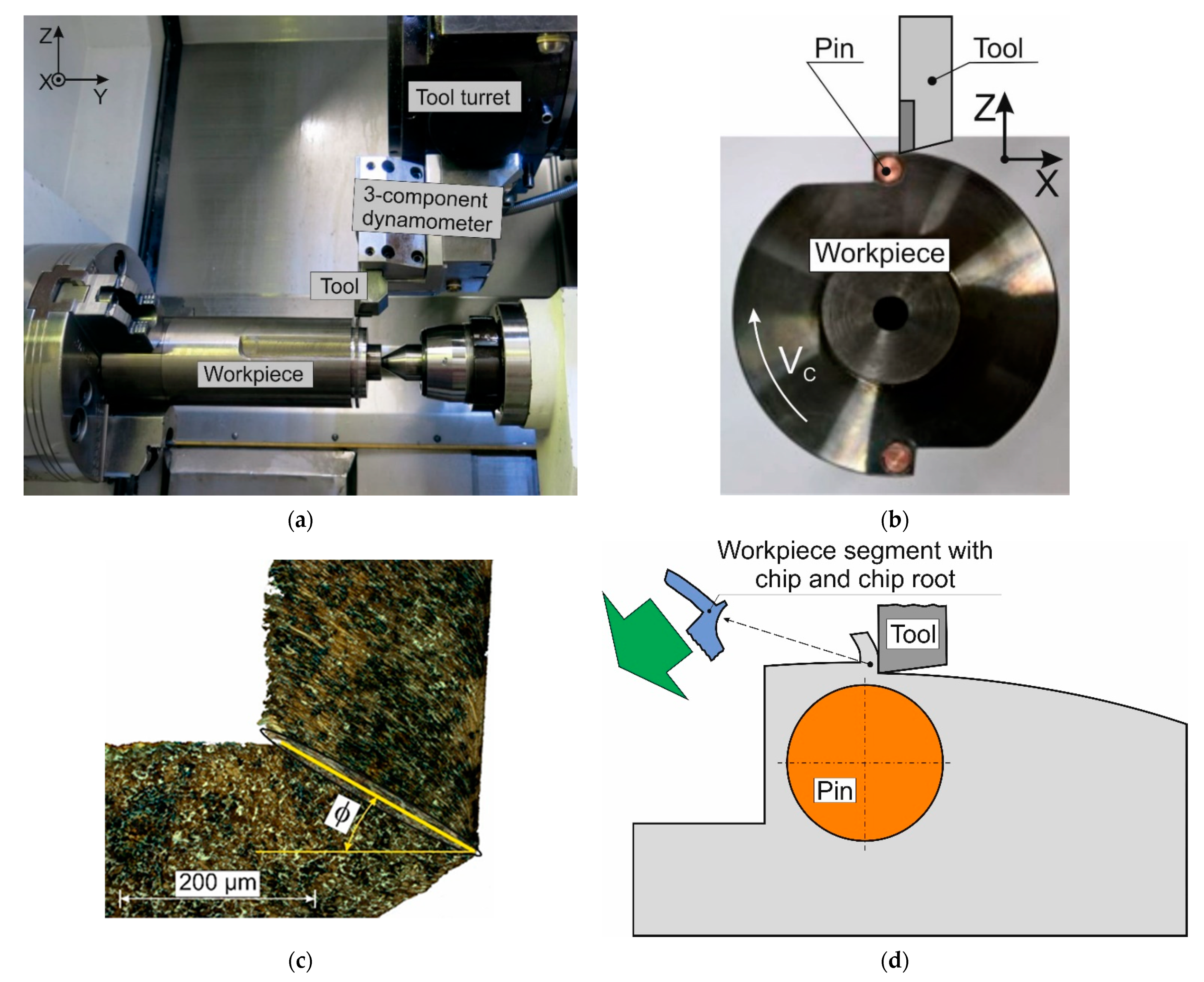
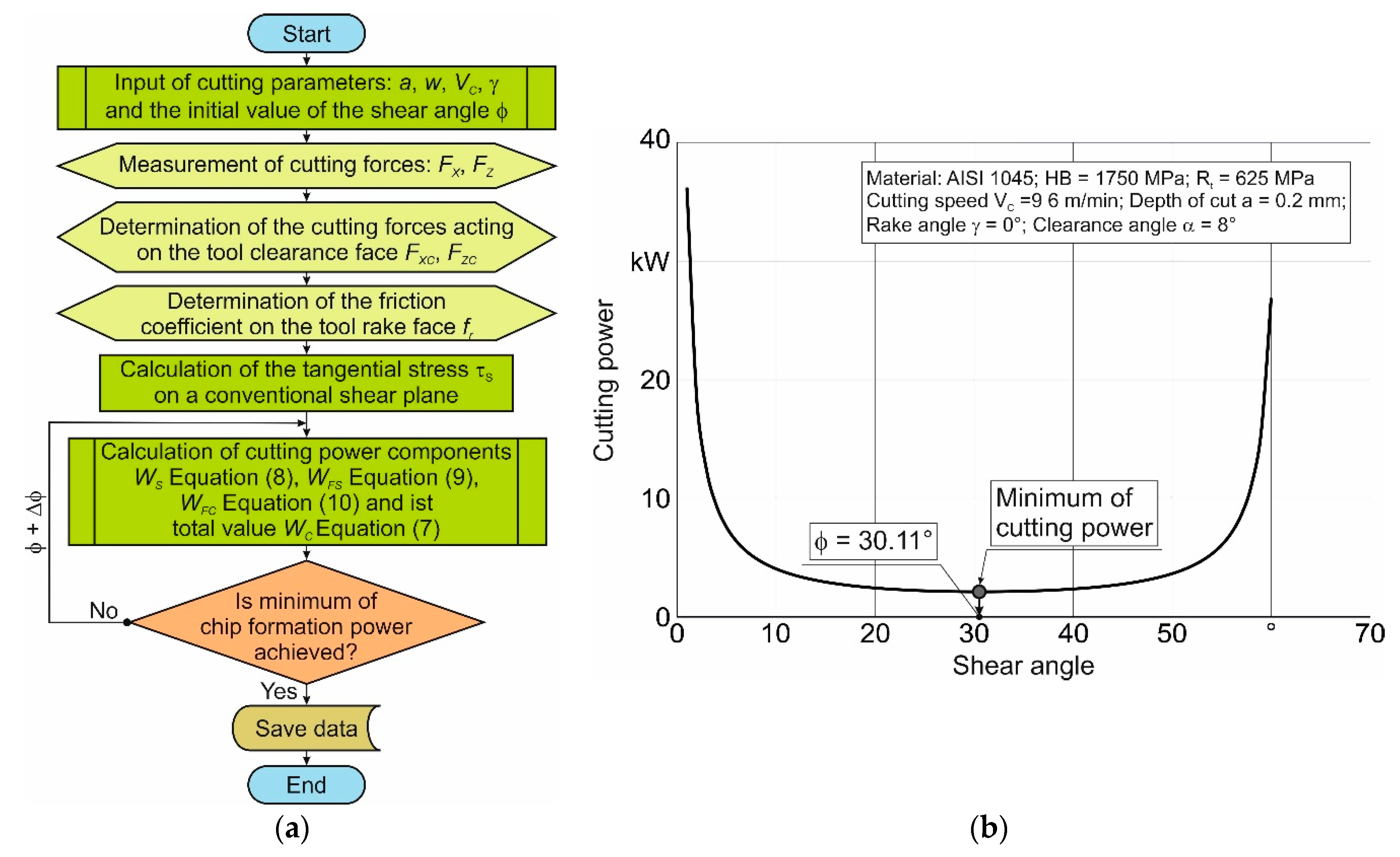


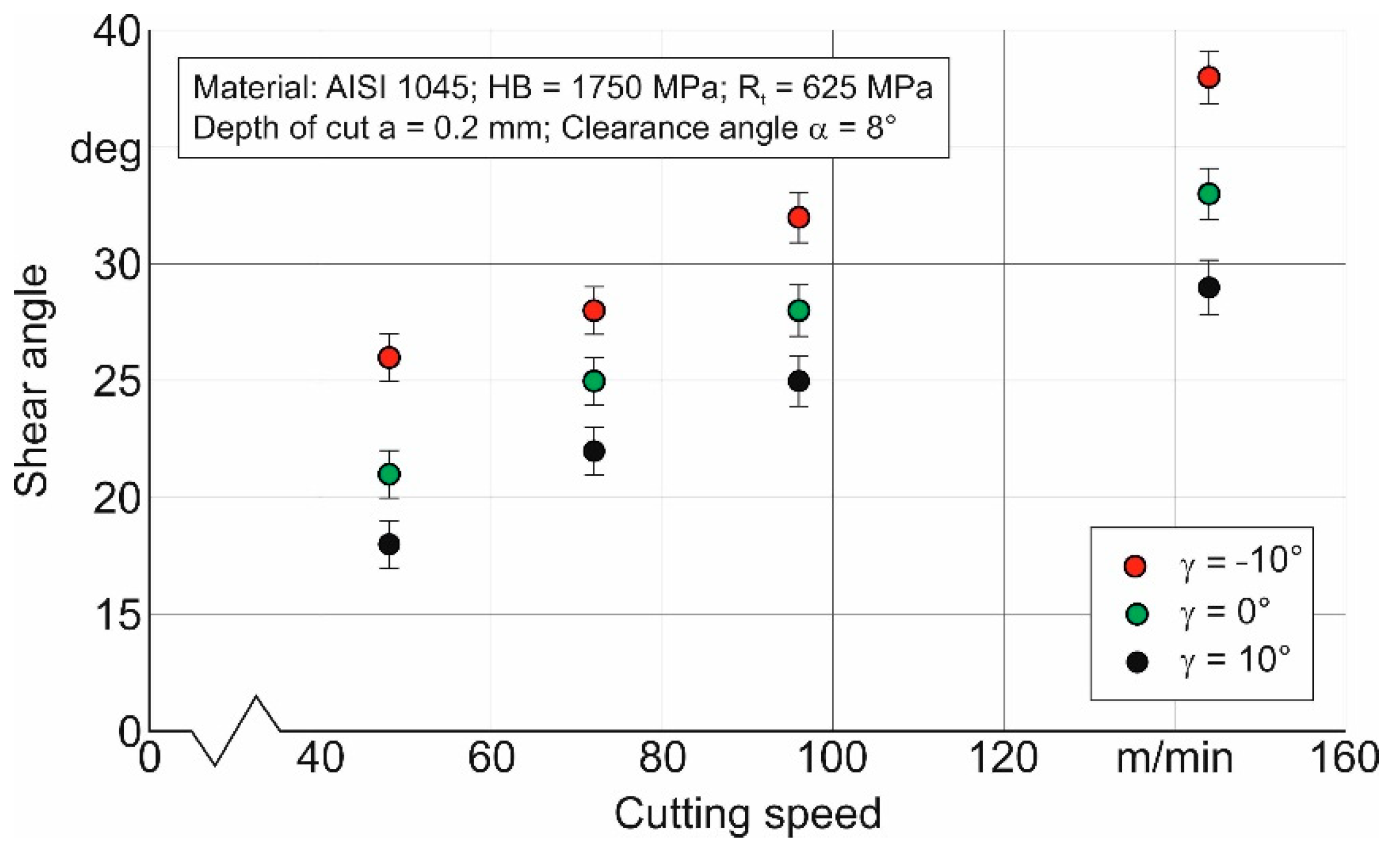
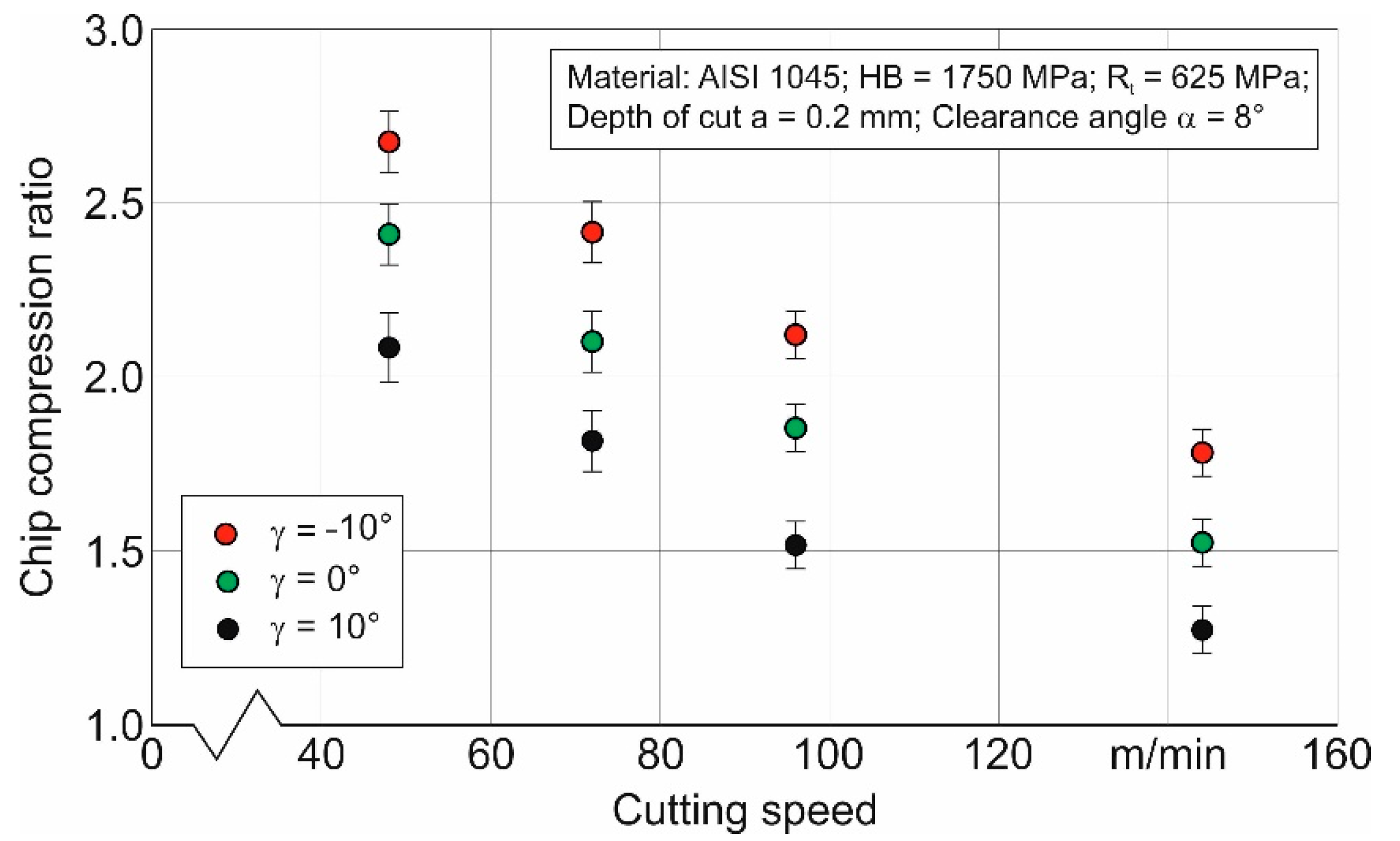
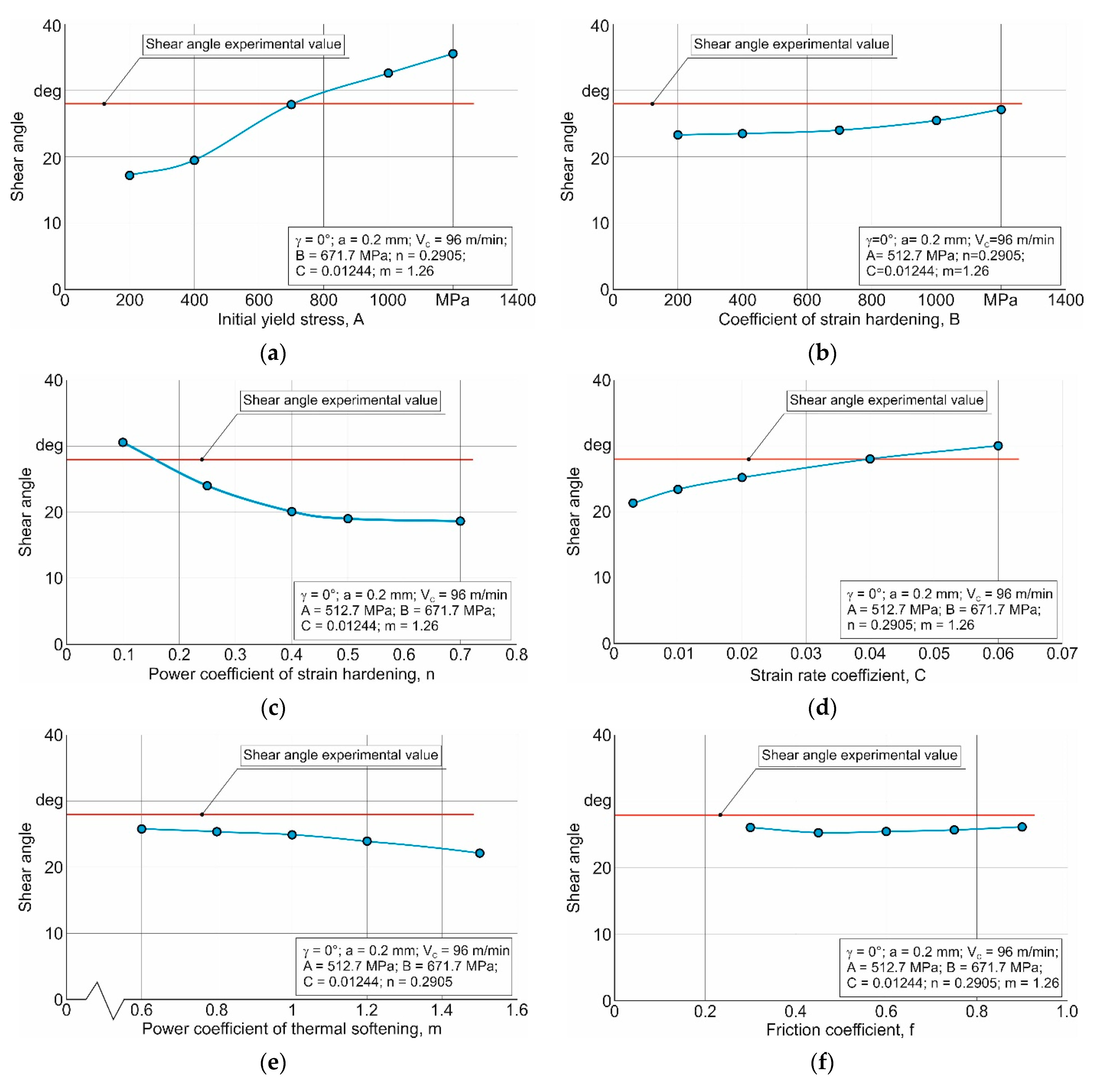
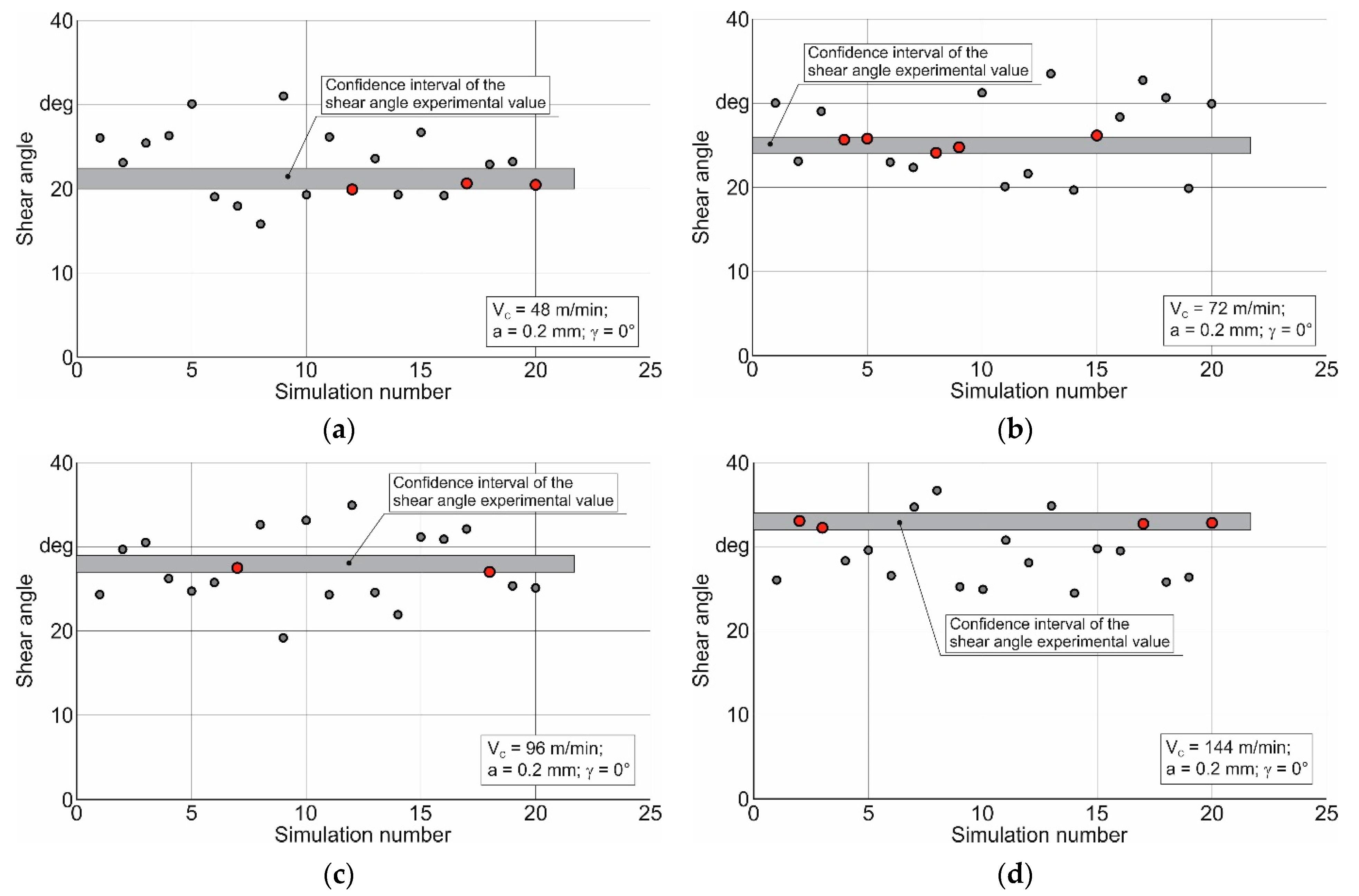

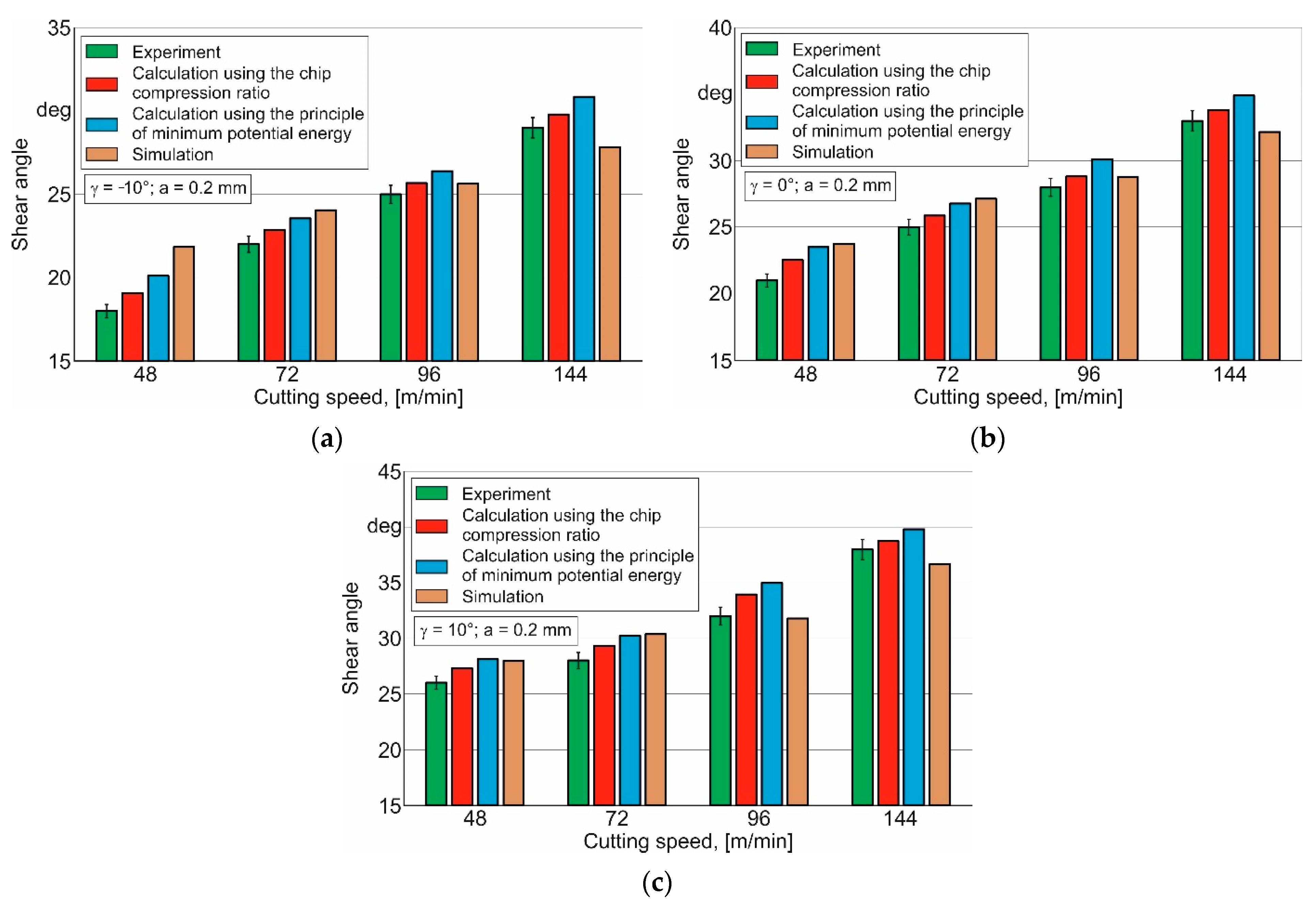
| Material | Strength (MPa) | Elastic Modulus (GPa) | Elongation (%) | Hard-Ness | Poisson’s Ratio | Specific Heat (J/kg·K) | Thermal Expansion (µm/m·°C) | Thermal Conductivity (W/m·K) | |
|---|---|---|---|---|---|---|---|---|---|
| Tensile | Yield | ||||||||
| AISI 1045 | 690 | 620 | 206 | 12 | HB 180 | 0.29 | 486 | 14 | 49.8 |
| SNMG-SM-1105 | - | - | 650 | - | HRC 76 | 0.25 | 251 | - | 59 |
| Constitutive Parameters | ||||
|---|---|---|---|---|
| A [MPa] | B [MPa] | n | C | m |
| 512.3 | 671.7 | 0.2905 | 0.01244 | 1.26 |
| A [MPa] | B [MPa] | n [−] | C [−] | ||||
|---|---|---|---|---|---|---|---|
| Upper limit | Lower limit | Upper limit | Lower limit | Upper limit | Lower limit | Upper limit | Lower limit |
| 1000 | 600 | 1200 | 800 | 0.27 | 0.08 | 0.1 | 0.05 |
| Constitutive Parameters | ||||
|---|---|---|---|---|
| A [MPa] | B [MPa] | n | C | m |
| 853.5 | 925.6 | 0.19565 | 0.0657 | 1 |
Publisher’s Note: MDPI stays neutral with regard to jurisdictional claims in published maps and institutional affiliations. |
© 2022 by the authors. Licensee MDPI, Basel, Switzerland. This article is an open access article distributed under the terms and conditions of the Creative Commons Attribution (CC BY) license (https://creativecommons.org/licenses/by/4.0/).
Share and Cite
Storchak, M.; Stehle, T.; Möhring, H.-C. Determination of the Shear Angle in the Orthogonal Cutting Process. J. Manuf. Mater. Process. 2022, 6, 132. https://doi.org/10.3390/jmmp6060132
Storchak M, Stehle T, Möhring H-C. Determination of the Shear Angle in the Orthogonal Cutting Process. Journal of Manufacturing and Materials Processing. 2022; 6(6):132. https://doi.org/10.3390/jmmp6060132
Chicago/Turabian StyleStorchak, Michael, Thomas Stehle, and Hans-Christian Möhring. 2022. "Determination of the Shear Angle in the Orthogonal Cutting Process" Journal of Manufacturing and Materials Processing 6, no. 6: 132. https://doi.org/10.3390/jmmp6060132





